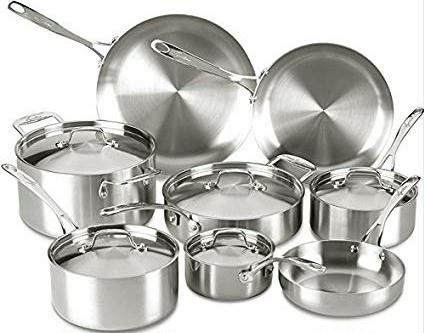
Steel and nickel aren’t on the critical mineral list, but nickel ought to be, since this study shows that there is a significant risk that stainless steel production will reach its maximum capacity around 2055 because of declining nickel production, though recycling, and use of other alloys on a very small scale can compensate somewhat.
The model in this study assumes business as usual for metal production and fossil fuel supplies (though the authors note that energy limitations are likely in the future, which will limit mining). If oil begins to decline within 10 years, as many think, shortages of stainless steel and everything else will happen before 2055.
There are two kinds of steel. Stainless which resists corrosion and is more ductile and tough than regular steel, also known as mild or carbon steel.
By weight, stainless steel is the fourth largest metal produced, after carbon steel, cast iron, and aluminum.
But stainless steel is limited by the alloying metals manganese (Mn), chromium (Cr) and nickel (Ni), which have limited reserves.
There are over 150 grades of stainless steel which is used for cutlery, cookware, zippers, construction, autos, handrails, counters, shipping containers, medical instruments and equipment, transportation of chemicals, liquids, and food products, harsh environments with high heat and toxic substances, off-shore oil rigs, wind, solar, geothermal, hydropower, battleships, tanks, submarines, and too many other products to name.
Steel of all kinds is crafted for a specific purpose with alloys added to make it harder, softer, more bendable, stiffer, corrosion resistant and more. It is used in every single kind of energy resource and vehicle made, wind turbines, solar panels, nuclear power plants, trucks and more as pointed out in the article at the bottom about iron ore. Renewable evangelists like to point out that steel can be made in electric arc furnaces, but most steel is made from scratch with iron ore, since recycled steel is lower quality, unable to be used by many industries without the special alloys specific to its function. In addition, many parts of the world don’t have the enormous amount of electricity required, or any steel to recycle.
Alice Friedemann www.energyskeptic.com Author of Life After Fossil Fuels: A Reality Check on Alternative Energy; When Trucks Stop Running: Energy and the Future of Transportation”, Barriers to Making Algal Biofuels, & “Crunch! Whole Grain Artisan Chips and Crackers”. Women in ecology Podcasts: WGBH, Jore, Planet: Critical, Crazy Town, Collapse Chronicles, Derrick Jensen, Practical Prepping, Kunstler 253 &278, Peak Prosperity, Index of best energyskeptic posts
***
Sverdrup HU et al (2019) Assessing the long-term global sustainability of the production and supply for stainless steel. Biophysical economics and resource quality.
The extractable amounts of nickel are modest, and this puts a limit on how much stainless steel of different qualities can be produced. Nickel is the most key element for stainless steel production.
This study shows that there is a significant risk that the stainless steel production will reach its maximum capacity around 2055 and slowly decline after that. The model indicates that stainless steel of the type containing Mn–Cr–Ni will have a production peak in about 2040, and the production will decline after 2045 because of nickel supply limitations.
For making stainless steel, four metals are essential and regularly used for making high quality steel, assisted by specialty metals for special properties:
- Iron for bulk of the stainless steel material
- Chromium for corrosion resistance
- Manganese for removing impurities and gain strength and workability
- Nickel for corrosion resistance, temperature resistance and hardness
- Molybdenum, cobalt, vanadium and niobium for strength, hardness, corrosion resistance and temperature resistance. Small amounts of nitrogen, phosphorus, silicon or aluminum is sometimes added to these alloys to fine-tune the properties of the material.
For stainless steels, metals like vanadium (occurs as a contaminant in almost all iron ore) are used for toughness and strength, tungsten, tantalum and niobium for extra hardness and high temperature resistance, cobalt for corrosion prevention. World production of stainless steel typically consists of 5–12% manganese, 10–18% chromium, 3–5% nickel and 0.1% molybdenum on the average.
Nickel is an important component in high-quality stainless steel (46% of supply), it is used in nonferrous alloys and super-alloys (34%), electroplating (14%), and 6% is used for other uses. There is no replacement for Nickle that exist, although chromium may be used for some of the functions of nickel in an alloy, and cobalt, molybdenum and niobium may do other alloying functions.
“Could even metals like iron, or manganese or chromium run out if we looked far enough into the future?”
Running their model until 3800 with business-as-usual figures, ” a critical time occurs around 2500 AD. Then most metals resources will have been depleted. Iron will be in abundant supply per person until about 2450, but then a sharp decline sets in. The same happens to manganese and chromium, then are sufficient until about 2500, and then the final decline comes, whereas the supply of nickel will be a trickle after 2300.”
Venditti (2022) Visualizing the World’s largest Iron Ore producers. Visual Capitalist. https://elements.visualcapitalist.com/visualizing-the-worlds-largest-iron-ore-producers/
Iron ore is 93% of the 2.7 billion tonnes of metals mined in 2021, with 98% of it going towards making steel. Although mined in over 50 countries, just 7 account for 82% of world production.
Country 2021 Production (Tonnes)
Australia… 900,000,000
Brazil……. 380,000,000
China……. 360,000,000
India…….. 240,000,000
Russia….. 100,000,000
Ukraine…… 81,000,000
Canada…… 68,000,000
South Africa 61,000,000
Kazakhstan 64,000,000
Iran……….. 50,000,000
Iron is the fourth most abundant element on the planet after oxygen, silicon, and aluminum, constituting about 5% of the Earth’s crust. Australia produced 35% of the iron ore mined last year.
China consumes the most iron ore, importing 80% of the iron ore it uses each year.
Steel is used extensively in agriculture, solar and wind power, and also in infrastructure for hydroelectric as well as transformers, generators, and electric motors, along with ships, trucks, and trains.

4 Responses to Peak stainless steel